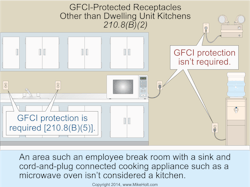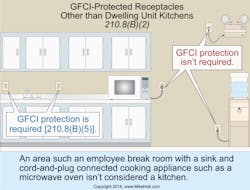Q. What are the GFCI protection requirements for receptacles?
Find the Answer
A. Ground-fault circuit interruption for personnel must be provided as required in Sec. 210.8(A) through (D). The ground-fault circuit-interrupter (GFCI) device must be installed at a readily accessible location. According to Art. 100, “readily accessible” means capable of being reached quickly without having to climb over or remove obstacles, or resort to portable ladders.
Dwelling units
GFCI protection is required for 15A and 20A, 125V receptacles in the bathroom area of a dwelling unit [210.8(A)(1)]. See the definition of “Bathroom” in Art. 100. In the continued interests of safety, proposals to allow receptacles for dedicated equipment in the bathroom area to be exempted from the GFCI protection requirements have been rejected.
GFCI protection is required for 15A and 20A, 125V receptacles in garages, and in grade-level portions of accessory buildings used for storage or work areas of a dwelling unit [210.8(A)(2)]. See the definition of “Garage” in Art. 100. A receptacle outlet is required in a dwelling unit attached garage [210.52(G)(1)], but a receptacle outlet isn’t required in an accessory building or a detached garage without power. If a 15A or 20A, 125V receptacle is installed in an accessory building, it must be GFCI protected.
15A and 20A, 125V receptacles located outdoors of dwelling units, including receptacles installed under the eaves of roofs, must be GFCI protected [210.8(A)(3)]. Each dwelling unit of a multifamily dwelling that has an individual entrance at grade level must have at least one GFCI-protected receptacle outlet accessible from grade level located not more than 6½ ft above grade [210.52(E)(2)]. Balconies, decks, and porches that are attached to the dwelling unit and are accessible from inside the dwelling must have at least one GFCI-protected receptacle outlet accessible from the balcony, deck, or porch [210.52(E)(3)].
Exception: GFCI protection isn’t required for a receptacle that’s supplied by a branch circuit dedicated to fixed electric snow-melting or deicing or pipeline and vessel heating equipment, if the receptacle isn’t readily accessible and the equipment or receptacle has ground-fault protection of equipment (GFPE) [426.28 and 427.22].
15A and 20A, 125V receptacles installed in crawl spaces at or below grade of a dwelling unit must be GFCI protected [210.8(A)(4)]. The Code doesn’t require a receptacle to be installed in a crawl space, except when heating, air-conditioning, and refrigeration equipment is installed there [210.63].
GFCI protection is required for 15A and 20A, 125V receptacles located in the unfinished portion of a basement not intended as a habitable room and limited to storage and work areas in dwelling units [210.8(A)(5)]. Exception: A receptacle supplying only a permanently installed fire alarm or burglar alarm system isn’t required to be GFCI protected [760.41(B) and 760.121(B)]. A receptacle outlet is required in each unfinished portion of a dwelling unit basement [210.52(G)(3)].
GFCI protection is required for 15A and 20A, 125V receptacles that serve countertop surfaces in a dwelling unit [210.8(A)(6)]. GFCI protection is required for all receptacles that serve countertop surfaces, but GFCI protection isn’t required for receptacles that serve built-in appliances, such as dishwashers, trash compactors, exhaust fans, or kitchen waste disposals. See Sec. 210.52(C) for the location requirements of countertop receptacles.
GFCI protection is required for 15A and 20A, 125V receptacles located within an arc measurement of 6 ft from the outside edge of a sink in dwelling units [210.8(A)(7)].
GFCI protection is required for all 15A and 20A, 125V receptacles located in a dwelling unit boathouse [210.8(A)(8)]. The Code doesn’t require a 15A or 20A, 125V receptacle to be installed in a boathouse, but if one is installed, it must be GFCI protected.
GFCI protection is required for 15A and 20A, 125V receptacles located within 6 ft of the outside edge of a bathtub or shower stall in dwelling units [210.8(A)(9)].
15A and 20A, 125V receptacles installed in laundry areas of a dwelling unit must be GFCI protected [210.8(A)(10)].
Other than dwelling units
15A and 20A, 125V receptacles installed in commercial or industrial bathrooms must be GFCI protected [210.8(B)(1)]. See the definition of “Bathroom” in Art. 100. A 15A or 20A, 125V receptacle isn’t required in a commercial or industrial bathroom, but if one is installed, it must be GFCI protected.
15A and 20A, 125V receptacles installed in a non-dwelling kitchen, even those that don’t supply the countertop surface, must be GFCI protected [210.8(B)(2)]. A kitchen is an area with a sink and permanent provisions for food preparation and cooking [Art. 100]. GFCI protection isn’t required for receptacles rated other than 15A and 20A, 125V in these locations. GFCI protection isn’t required for hard-wired equipment in these locations. An area such an employee break room with a sink and cord-and-plug-connected cooking appliance such as a microwave oven isn’t considered a kitchen. (Figure)
15A and 20A, 125V receptacles installed on non-dwelling rooftops must be GFCI protected [210.8(B)(3)]. A 15A or 20A, 125V receptacle outlet must be installed within 25 ft of heating, air-conditioning, and refrigeration equipment [210.63]. Exception No. 1 to (3): Receptacles on rooftops aren’t required to be readily accessible other than from the rooftop.
15A and 20A, 125V receptacles installed outdoors must be GFCI protected [210.8(B)(4)]. Exception No. 2 to (3) and (4): GFCI protection isn’t required for a receptacle that’s supplied by a branch circuit dedicated to fixed electric snow-melting or deicing or pipeline and vessel heating equipment, if the receptacle isn’t readily accessible and the equipment or receptacle has ground-fault protection of equipment (GFPE) [426.28 and 427.22].
15A and 20A, 125V receptacles installed within 6 ft of the outside edge of a sink must be GFCI protected [210.8(B)(5)].
Exception No. 1: In industrial laboratories, receptacles used to supply equipment where removal of power would introduce a greater hazard aren’t required to be GFCI protected.
Exception No. 2: Receptacles located in patient bed locations of general care or critical care areas of health care facilities aren’t required to be GFCI protected.
15A and 20A, 125V receptacles installed indoors in wet locations of non-dwelling units must be GFCI protected [210.8(B)(6)].
15A and 20A, 125V receptacles installed in locker rooms with associated showering facilities must be GFCI protected [210.8(B)(7)].
15A and 20A, 125V receptacles installed in non-dwelling unit garages, service bays, and similar areas must be GFCI protected, unless they’re in show rooms or exhibition halls [210.8(B)(8)].
GFCI protection is required for outlets supplying boat hoists in dwelling unit locations [210.8(C)]. See the definition of “Outlet” in Art. 100. This ensures GFCI protection regardless of whether the boat hoist is cord-and-plug-connected or hard-wired.
About the Author

Mike Holt
Mike Holt is the owner of Mike Holt Enterprises (www.MikeHolt.com), one of the largest electrical publishers in the United States. He earned a master's degree in the Business Administration Program (MBA) from the University of Miami. He earned his reputation as a National Electrical Code (NEC) expert by working his way up through the electrical trade. Formally a construction editor for two different trade publications, Mike started his career as an apprentice electrician and eventually became a master electrician, an electrical inspector, a contractor, and an educator. Mike has taught more than 1,000 classes on 30 different electrical-related subjects — ranging from alarm installations to exam preparation and voltage drop calculations. He continues to produce seminars, videos, books, and online training for the trade as well as contribute monthly Code content to EC&M magazine.

